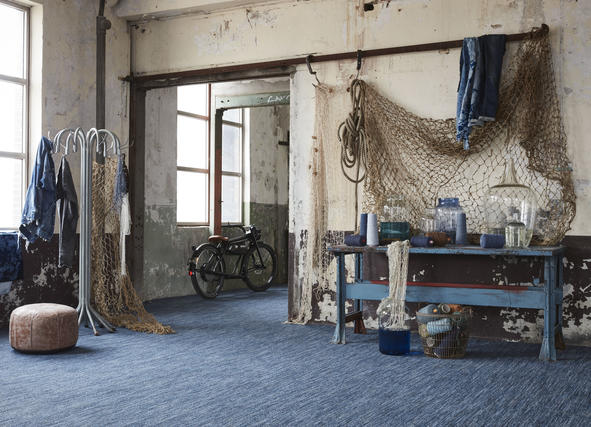
How to lay carpet
The installation of carpet and carpet tiles should always take place in conditions as close to those of the occupied space or building as possible.
Site conditions
The material should be unpacked at least 24 hours prior to installation and allowed to acclimatise to room temperature (48 hours in case of EcoBase™ backing). The product should be installed at a minimum room temperature of 18°C with a maximum relative humidity of 65%. A floor temperature of at least 10°C should be maintained.
Most of DESSO carpet and carpet tiles can be installed on floors with underfloor heating, providing the maximum operating temperature of the floor does not exceed 27°C. The heating should be turned off at least 48 hours prior to installation.
The final result of the carpet installation largely depends on the condition of the sub-floor,,so the preparation of this surface is of paramount importance.
- The floor should be clean, level, dry and free from any contaminants such as adhesives, oil, grease and polish. A new concrete slab should have a moisture content, when measured with a hygrometer, of less than 75% relative humidity.
- Dusty floors and surfaces that are very absorbent should be swept clean and the surface sealed with an approved sealer. The sealer should be allowed to dry before the application of any tackifier or adhesive system.
- Concrete screeds should be sound and any damaged areas or holes should be made good using an approved levelling compound (at least 3mm thick).
- Any existing flooring materials should be removed.
- Floorboards should be level and firmly fixed. Uneven surfaces should be levelled by the application of 6mm plywood, which may require sealing to prevent the absorption of applied tackifier or adhesive.
Fitting carpet tiles
Once the working area has been coated with a tackifier and the application is completely dry, the tiles can be installed using standard fitting techniques. Early placement of the tiles, i.e. when the tackifier is still wet, will result in a permanent bond. The application of tackifier to provide all-over cover is recommended. Raised access floor panels need careful treatment to ensure that the tackifier in its wet state does not penetrate the joins between adjacent panels.
Most Desso carpet tiles, particularly the cut pile ranges, are normally installed with the directional arrows all pointing in the same direction (“monolithic” installation). Some tiles have a very pronounced pile direction or design and have to, or can be installed "Quarter-turn", "Ashlar" or ''Brick'' i.e. (look at Technical Specification of product).
Fitting broadloom carpet
A permanent adhesive system is recommended to fix the carpet directly to a suitably prepared sub-floor. Seaming should be carried out by the overlap and cut through technique as we are unable to guarantee a straight edge for the whole length of the "cut" or roll.
In the case of patterned carpets the edge has to be cut single. A satisfactory match should be ensured by stretching prior to bonding. A glider should be used throughout to ensure that all air bubbles are removed and that good contact is made with the adhesive.
For commercial use it is strongly recommended that tufted carpet is bonded directly to the subfloor, however sometimes it may be necessary to support the carpet with a resilient underlay.
This technique specifies that the underlay is "adhered" to the suitably prepared sub-floor using a "tackifier" or adhesive and the carpet is then bonded to the underlay with a permanent adhesive. Please note that dimensional stability cannot be guaranteed under chair castors using underlay double stick systems.
How to lay carpet on stairs
Stairs in commercial premises may vary in their material construction and in their profile. The end-user may require a full broadloom effect achieved by cascading the carpet continuously down the staircase. Most stair constructions in commercial premises however will require nosings with carpet bonded directly to the stair base. The specification of an underlay will require a different technique.
Download the Carpet installation guide for more detailed installation instructions. This document can also be found on each product page.